This post is part of a larger deep dive
Curious about the role of the Spanish Civil War and "The Consequences of War" by Peter Paul Rubens in Guernica? Check out Guernica Explained!
Or read the full Guernica article!
This post is part of a larger deep dive
Curious about the role of the Spanish Civil War and "The Consequences of War" by Peter Paul Rubens in Guernica? Check out Guernica Explained!
Or read the full Guernica article!
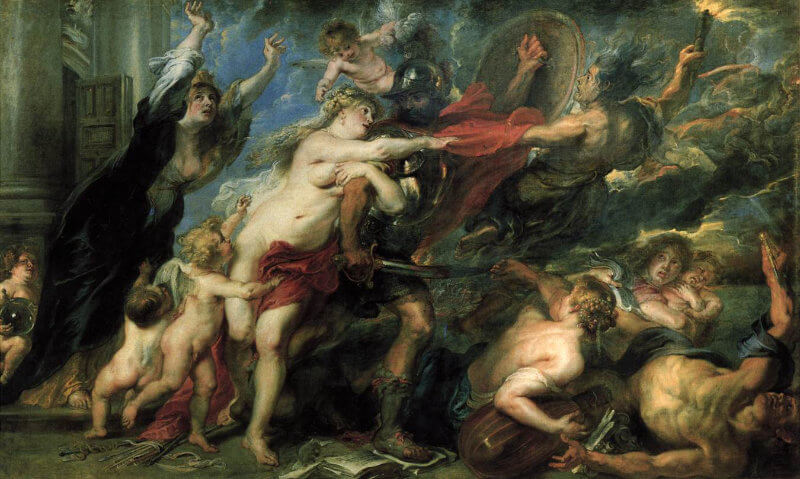
Peter Paul Rubens was a Flemish painter from the XVII century.
He lived during a period called the Thirty-years war. This conflict, which spanned 30 years (1618-1648), was one of the most destructive events in the history of Europe, and responsible for the deaths of millions of people, with some territories seeing a staggering decline in population.
Looting and setting fields on fire was in the order of the day; famine and disease were rampant.
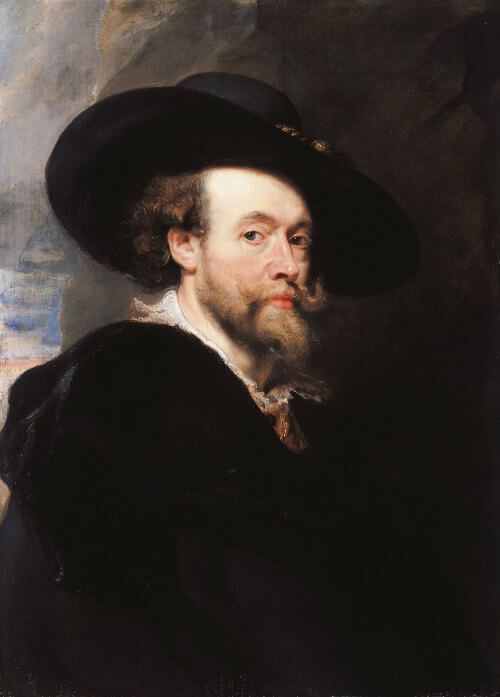
Sometime between 1637-1638, Artist Justus Sustermans commissioned Rubens to produce “The Consequences of War” (sometimes also named “The Horrors of War”).
Rubens was deeply affected by how war had been ravaging his native land, and “The Consequences of War” serves a commentary showing the destruction in Europe caused by this devastating war.
“The Consequences of War” is an allegory. That is, the characters and events depicted in the painting are merely symbols representing moral, political or religious ideas.
Below, I’ll briefly describe some of the major elements in this painting and their putative meaning.

In Ancient Rome, the temple of Janus was a small temple located in Rome. During times of peace, the doors of the temple would remain closed, whereas during periods of war, the temple’s doors would be opened.
Janus is the god of beginnings and passages and is often portrayed as two heads facing away from each other (see figure above).
In Ruben’s painting, we can see the temple of Janus located at the far left, flanked by two enormous columns. A sculpture of Janus (with its distinctive two faces placed in opposite directions) can also be seen above the gates of the temple. The gates are open, indicating war.
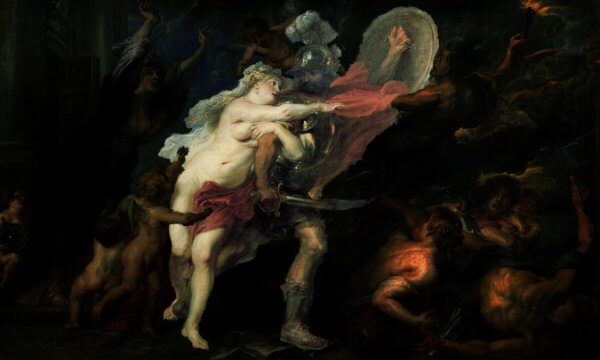
The warrior at the centre of the composition is Mars, the Roman god of War. His red cape emphasises his identity as the god of War.
In the painting, Mars appears to have burst out of the temple of Janus, unleashing terror. He is carrying a shield and a bloodied sword, threatening the people around him.
In Roman mythology, Mars revels in fighting, and was believed to be the protector of Rome.
The female figure grasping Mars’ right arm is Venus, the Roman goddess of love and Mars’ mistress.
Venus is futilely attempting to restrain Mars’ attack with caresses and embraces. She counts with the help of Cupid and Amors in her endeavor to placate Mars and maintain peace.
Notice how Venus is much brighter than the rest of the painting. Most of the canvas has a darker tonality, therefore depicting discord, destruction, sadness.
Venus and her helpers, on the other hand, are much brighter, and represent the love, beauty and rays of hope that still linger among humans in spite of this devastating war.
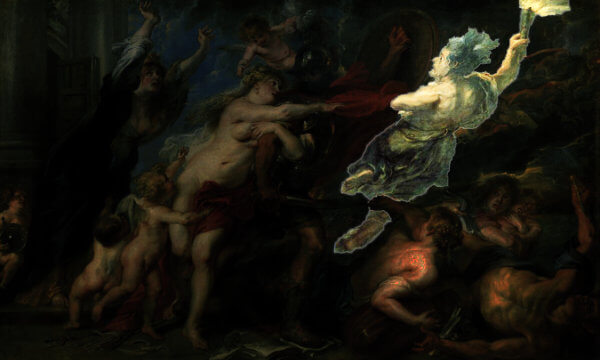
In Greek mythology, furies are goddesses of vengeance. Alecto is one of the three furies and personifies anger.
According to myth, Alecto was recruited by Juno to set off the Trojan War. After King Turnus mocked her persuasion attempts at igniting the war against the Trojans, Alecto used a burning torch to bring King Turnus’ blood to “boil with passion for war”.
In Rubens’ painting, Alecto is galvanising Mars into action. She has a terrifying look in her eyes and is waving her torch above Mars, inciting him to wreak havoc.
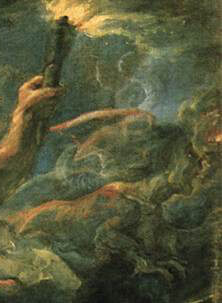
The two monsters at the upper right corner of the canvas symbolise pestilence and famine, terrible consequences of war.
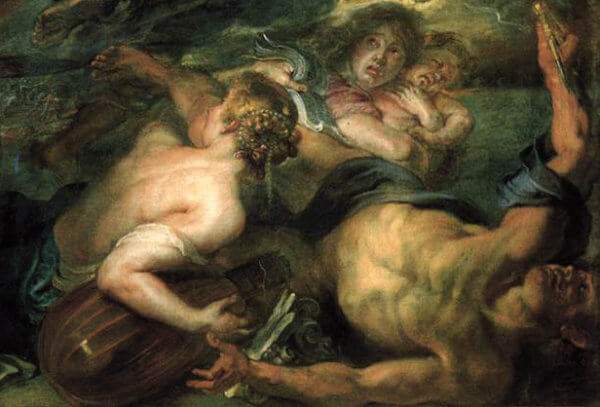
On the right side of the painting we can see a terrified woman carrying a (possibly dead) child in her arms.
According to Rubens, these two figures represent the bruise that war causes on fecundity, procreation and charity.
The woman lying on the floor with a lute and her back towards us personifies Harmony.
The neck of the lute is broken, symbolising that even music is not left unscathed by the destruction caused by war.
On the right corner a man has been thrown to the ground. He is an architect, as suggested by the instruments he is still holding in his hands such as a compass.
With it, Rubens wanted to convey the idea that war destroys everything of beauty that man is able to create at times of peace.
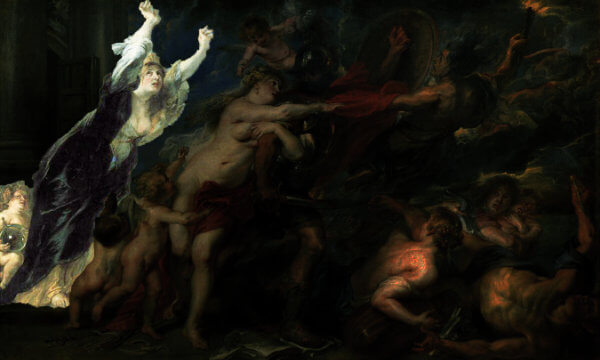
The woman on the left of the painting with her arms stretched up and a look of despair on her face symbolises Europe.
Although a crown is visible on her head, she has been robbed of all her jewels and ornaments. This means that Europe’s wealth (not just material wealth, but also stability) has been stripped away. She has dropped a globe (a defining attribute of Europe), which has been caught by one of the Amores.
This figure clearly represents the continent of Europe, which, at the time, was being ravaged by destruction and chaos caused by the Thirty Years war.

The arrows on the ground bundled together with a leather band are supposed to symbolise Concord (a symbol of unity and agreement in a society). The band that held the arrows together has been loosened however, suggesting discord among people.
Next to the arrows is a cauduceus, a symbol of peace.
Both of these objects appear to have been neglected and tossed aside. Rubens clearly wished to depict how qualities such as friendship, unity, agreement, have all been contaminated and now only disunity and discord reign.
Also, note how Mars is stepping on a book and a drawing on a paper, a clear suggestion of war’s pernicious effects on the arts and letters (and a society’s culture in general).
Likewise, Harmony’s broken lute and the unconscious Architect holding a compass could symbolise the destruction of music and architecture.
Only with a simply contrast b/w lenguage, that a child can easily undrestand, if you are a human(not you in this case).
With primeval figures in their desperation and most dramatic moments in their life and dead.
Almost like graffiti artists do in the same size today.
He brings us “The Horror of War”, but he is also warning to us.
A different war is coming.
The Spanish Civil War was reported by important journalists of the time.
This picture alerted and made the world aware of the pain and suffering that this new type of war brought with it, the so-called aerial bombardment of the civilian population.
Europe will experience it later in World War II.
For the painter it was a way of giving voice to his people and his message.
The press of those years was in b/w and the cinema too, except for some blockbusters with a very high budget.
In order to spread and raise funds for the Republican side (Defenders of democracy), against the Nationals (Franco dictatorship).
He presented his work at the Universal Exhibition in Paris in 1937.
Obtaining recognition and impact at a global level.
Those pioneers of graphic journalism of the time, in a photograph of the painting in b/w or without color.
They managed to convey the message of the painting to their readers, and after the passing of the years, it still retains the strength of its original genesis.
Whoever you are and regardless of who you are.
Thanks for your comment Cris! I think you have nicely summarised Picasso’s intentions with Guernica and the impact it had on the audience with this comment.
I admit I could have given more focus on Picasso’s sentiment towards the war, which naturally needs to be taken into account in any analysis of Guernica. I mentioned it in passing at the end of the Review section, but I should have probably elaborated on it.
I fully acknowledge Guernica’s potentiality as an anti-war symbol and this, by itself, is noteworthy; it is in fact one of the aspects of the painting that fascinates me. Unfortunately, reviewing the work as a whole, I do not think the quality of the painting is on par with the message it embodies.
lacklustre?
Inspired to inspire your deadclock imagine
Hi Cris. Yes, perhaps “lacklustre” was a poor choice of a word. But I was refering to the visual elements of the mural. To me, they simply don’t do justice to the intrinsic message of the painting, which I find profound.
However, art is subjective, and my opinion is really just that, an opinion. I tend to lean more towards classical art than abstract/cubist art, and my article likely reflects this inclination.